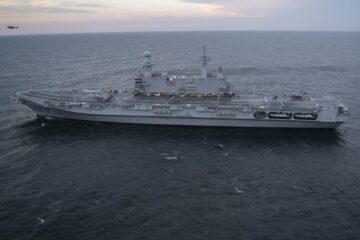Speaking to media by telephonic conference from Australia, Admiral Fagan said, “The United States, Australia and many Pacific countries have shared goals, and the coast guard works to strengthen relationships with partners throughout the region.”
Naval News asked the commandant how the USCG can assure nations being bullied by the world’s largest maritime law enforcement agency, the China Coast Guard, in places like the South China Sea. She responded, “So, the United States Coast Guard, as we operate around the world – and certainly we have US Coast Guard cutters in the Pacific, in Oceania – we demonstrate what professional maritime behaviours and engagements are on the water. We operate and navigate in accordance with international law in a way that’s professional and predictable.”
She explained that the USCG seeks to be a model as it interacts with any coast guard, navy or commercial vessel in the Pacific. She added: “We continue to demonstrate what professional behaviours are, certainly consistent with the international rules-based order, and mindful that each and every nation has their sovereignty that needs to be respected. And I think…the US Coast Guard does a particularly good job of operating in that space in a way that’s professional, relevant and useful to so many key partners and allies in the region.”

Although directly avoiding reference to China and its aggressive coast guard by name, she reasserted US commitment to a free and open Indo-Pacific where safety, security and prosperity are something that all mariners and all nations should enjoy.
She noted that several coast guard cutters have transited the Taiwan Strait, which is “an agreed, accepted international strait, and…we will operate and navigate our coast guard ships consistent with international laws and norms, and will continue to operate consistent with all the codes of conduct as it pertains to ship engagements at sea,” whether military ships, law enforcement vessels, fishing boats or commercial ships.
Admiral Fagan pointed out that the Indo-Pacific region is home to half the world’s population and two-thirds of the global economy.
“We are more interconnected now than we have ever been.”
“Our oceans are global highways that facilitate commerce and provide food to millions of people. Threats to maritime security do not respect borders, so it’s important that we work together with partners to solve shared challenges. For example, illegal, unreported and unregulated fishing threatens the health of our oceans, and the wellbeing of coastal communities that rely on fishing for their livelihood and for their food security.”
Admiral Linda L. Fagan, 27th Commandant of the USCG

Responding to another Naval News question, the admiral stated: “A recurring theme on this trip, and other trips that I’ve made into the region, is interest and desire for more engagement and partnership with the US Coast Guard. And, you know, often that focuses on white ships with the red racing stripes.”
She gave the example of USCGC Harriet Lane (WMEC 903), a medium-endurance cutter currently en route to Vanuatu. Normally homeported in Honolulu, it had just completed an inaugural patrol with Samoan law enforcement under Operation Blue Pacific to support efforts to combat illegal fishing in Oceania. The USCG has a bilateral agreement with Samoa to assist with fishery patrols in Samoan waters.
The USCG has had ships operating in the Indo-Pacific for the past few years. It conducted a joint patrol with the Philippine Coast Guard in October 2023, and regularly collaborates with coast guards from nations like Indonesia, Japan and Malaysia. The US service also cooperates with the Australian Border Force, and both nations are members of the Quad Maritime Security Working Group.
She said that instead of focusing just on ships, the USCG is seeking to create opportunities for more persistent engagement in the Indo-Pacific region. This includes, for instance, “training teams to come and teach everything from law enforcement fisheries boardings to outboard engine repair,” or any other topic of interest.
She added that the USCG “is particularly well suited for that kind of training and work, and the demand signal is quite loud for it, and we look forward to continuing those kinds of critical, not just training, but ship deployment opportunities as well”.

The USCG is just a single agency, but there is a clear desire to more effectively integrate and align with other US armed services. For instance, the coast guard played an important role in Exercise Talisman Sabre 2023 in Australia, despatching around 100 deployable specialized forces like Port Security Unit 321 and Maritime Safety and Security Team 91105 from San Francisco. They performed missions such as securing Gladstone port and safeguarding a Joint Logistics Over The Shore (JLOTS) site in Bowen.
Multilateral efforts are critical for the USCG too. Examples are the New Zealand initiative called Starboard Maritime Intelligence, promulgation of the US-led SeaVision web-based maritime situational awareness tool under the Quad, and also the HawkEye 360 commercial venture. She said the USCG is synchronized with and supportive of all such maritime domain awareness efforts.
When asked about China’s “grey zone” tactics in the South China Sea, the commandant simply contrasted that behaviour with how the US “always operates in accordance with the agreed international order, rule of law, the conducts and codes that govern how mariners and military vessels operate and conduct themselves at sea.” As well as demonstrating such professionalism itself, she said the USA would also help ensure that nations have capacity to counter illegal activities or encroachments of sovereignty.
She concluded, “I’m really excited about the opportunities that exist…to help bolster and strengthen the network and fabric of so many like-minded countries who have a right to their sovereignty and protecting their own natural resources.”






